Retinoic ointment is a preparation for external and internal use based on isotretionine, a form of vitamin A. It is widely used in dermatological practice.
The effect of isotretionine on the human body has not been fully studied, but it is reliably known that this substance affects all systems of the body.
Composition of the product
The composition of this drug includes (in descending order):
- isotretionine 0.05 g;
- butylated hydroxytoluene;
- butylated hydroxyanisole;
- emulsion wax;
- Vaseline oil;
- glycerol;
- ethanol;
- purified water.
The main active ingredient is the biologically active substance isotrethionine, the remaining components are auxiliary, necessary for ease of application, as well as achieving a viscous consistency.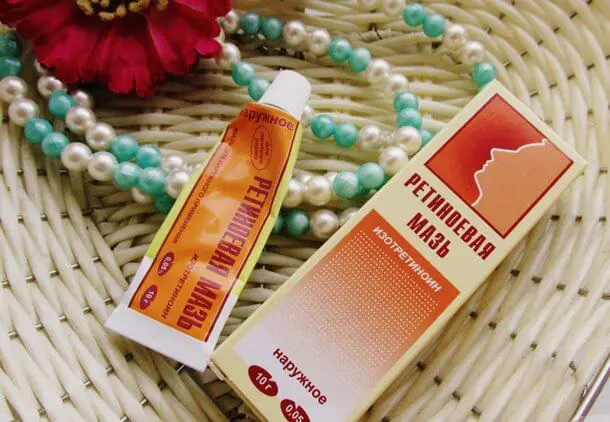
Indications and contraindications
This remedy must be used after consultation with a doctor, often when:
- skin problems (pimples, ulcers, blackheads, comedones);
- the product has a “drying” effect;
- normalizes the functioning of the sebaceous glands, reduces the formation of secretions, which is an excellent substrate for the proliferation of infection and bacteria;
- has some anti-inflammatory effect;
- activates healing processes and renewal in epithelial tissues.
Under no circumstances should you self-medicate or use the product without a doctor’s prescription.
All isotretionine-containing medications (including retinoic ointment for acne on the face), as well as vitamins A, are strong teratogens, i.e. substances that provoke severe mutations and deformities in the fetus during intrauterine development.
The ointment is contraindicated for use:
- pregnant women at any stage of pregnancy;
- when breastfeeding;
- individual intolerance;
- liver failure;
- hypervitaminosis A;
- joint therapy with tetracycline;
- disorders of the kidneys and liver.
How to use
Like any medicine, retinoic acne ointment should be used only for its intended purpose for medicinal purposes according to the instructions. When applied topically, you should adhere to the following recommendations, which describe how to use retinoic ointment for acne:
- The skin should be cleaned of impurities.
- Pat dry with a clean towel.
- Apply the composition in a thin layer evenly only to problem skin with light circular movements, being careful not to rub.
The duration and frequency of use of retinoic ointment for acne depends on the recommendations and reviews of the dermatologist, as well as the intensity of the rash. The duration of applications with retinoic ointment for acne can last up to three months in accordance with the instructions for use.
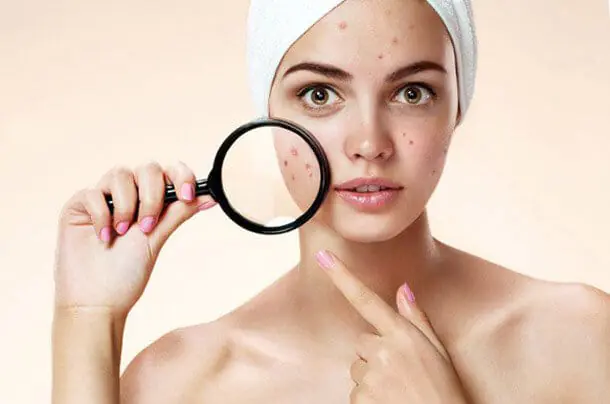
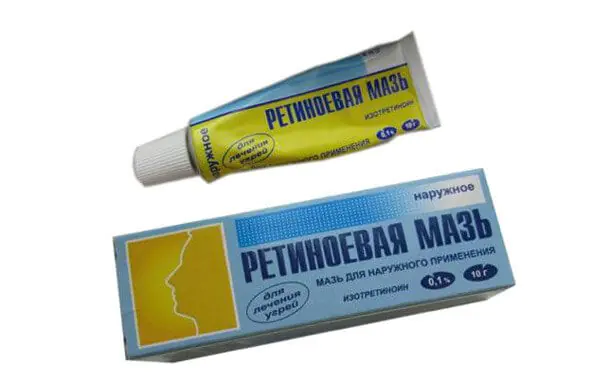

Where can I buy
| Pharmacy name | Address | A drug | Price, rub |
|---|---|---|---|
| Alexandrovskaya Pharmacy | Moscow, st. Generala Belova, 9 | Retinoic ointment 0.05% 10g | 264 |
| Planet Health | St. Petersburg, lane. Kuznechny, 17/2 A | Retinoic ointment 0.05% 10g | 295 |
| Online Pharmacy | Minsk, Nezavisimosti St. 155/1 | Retinoic ointment 0.05% | 12 bel. R |
| Online pharmacy Farmnova | Kyiv | Retinoic ointment 0.1% 10g | 379.5 UAH |
Is it possible to leave the ointment on overnight?
Retinoids are quite active substances, and compositions based on them may cause some skin reactions after use. For example, redness, peeling, mild itching. As a rule, such reactions are minor and pass quickly. But with prolonged exposure to large amounts of retinoic acne ointment, unpleasant consequences are possible, including chemical burns and blisters.
You can read reviews about use, look at before and after photos, before finding out experimentally whether retinoic ointment helps with acne. In any case, it is strongly recommended not to apply the product generously and for a long time, especially at night.
To ensure that the body is reacting normally to the drug, you can apply it to a small area of skin to monitor its reaction throughout the day.
Will acne go away forever?
It is important to realistically assess the capabilities of retinoic ointment and start from how serious the form of skin rash in the form of acne is. In numerous reviews and in the photos presented below, you can clearly observe the healing effect.
But you shouldn’t expect miraculous relief after several uses of retinoic acne ointment for severe inflammatory rashes in large quantities, although reviews and before and after photos say otherwise.
Only complex long-term therapy will give results. However, if you use retinoic ointment against small pimples, then it can be considered quite effective, allowing you to get rid of hated pimples for a long time.
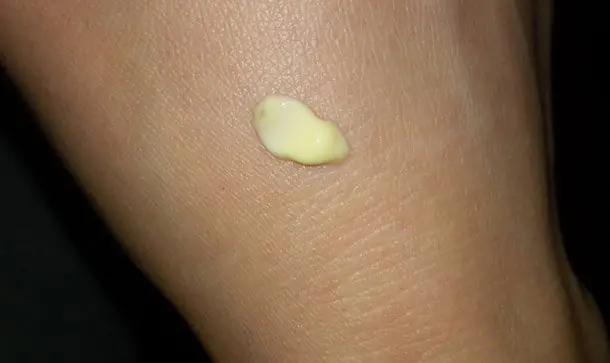
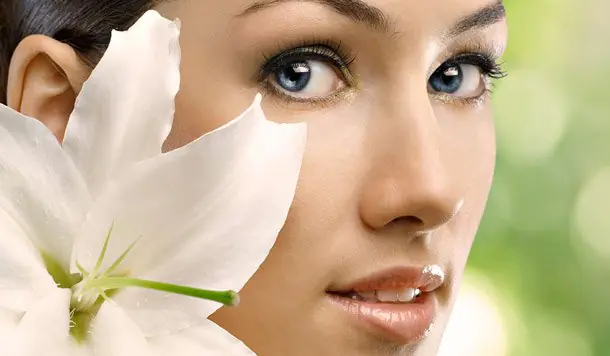
Analogues of the drug
There are not many analogues to this product. Other retinoids with similar active substances include:
As a rule, the above drugs are used, for the most part, as a tool to combat fine expression wrinkles. However, based on the composition, they can sometimes be used not only for rejuvenation, but even against inflammatory reactions on the skin.
You should not purchase or use the listed medications yourself without first consulting your doctor.
Product reviews
The analysis of opinions about retinoic ointment was based on reviews on the Internet. It should be said that this acne remedy has conflicting reviews. For the most part, they are positive, but there are also those who are not entirely happy with the effect and even received a chemical burn as a result of application.
Tatyana Golovko, 24 years old:
I’ve suffered from problem skin since I was a teenager, and I’ve tried everything I’ve tried during that time. By chance, on the Internet, I came across an article about retinoic ointment for acne. I became interested, read the reviews, and the next day I went and bought it. My skin is quite oily, but after about a week of use it became much better. Although, in the first days I could not avoid redness and peeling. As a result, it’s already the third month of using this product. The one person who benefited from retinoic acne ointment was me. I won’t say that my skin has become perfect, but there are much fewer acne spots, and my face no longer looks like a sandwich with butter. I still use the product, but a friend said that long-term use can cause burns. That is why I am going to visit a doctor to avoid negative consequences.
Oksana Pechorina, 17 years old:
My friend and I were watching TV one day, and in a program about health we heard about this ointment. It said that it helps in the fight against wrinkles and acne. I told my mom, she bought me retinoic ointment. They started using it together, only my mother for wrinkles, and I smeared it on my pimples and acne marks. My mother liked it, she says that she began to look younger, but I didn’t really like it, my skin was very hot, so I stopped using it completely. However, the problems did not end there: after 2 days, my face became very red and began to itch, so I had to run to the doctor. After an examination and a couple of tests, a burn and a severe allergic reaction were diagnosed. Now I am already treating completely different ailments. I do not recommend buying this product without consulting a doctor.
Liliya Gorodnichuk, 40 years old:
I have been familiar with this drug for quite a long time, sometimes I do so-called retinoic peels at home - a cool thing! But then my son became quite an adult, he learned all the “charms” of adolescence in the form of huge inflamed pimples on his youthful face, even on his back. She took me to a dermatologist; one of the medications he prescribed was retinoic ointment. What I want to say: it definitely helped, that’s why I left a review. For about a month we were treated for acne, of course, strictly following the instructions for use. Only then did visible results appear. The skin became much clearer, pinker, there were fewer blackheads, and the inflamed pimples disappeared completely.
Acne treatment is a direction in dermatocosmetology, the task of which is to relieve inflammation, normalize the functioning of the sebaceous gland and prevent scarring of the skin.
Many reasons serve as provoking factors that cause the disease. This could be stress, hormonal changes in the body, improper skin care, or the presence of concomitant diseases.
Therefore, acne should be treated by a doctor who, after establishing the cause of the disease, prescribes therapy depending on the severity.
Causes of the rash
The development of acne is based on 4 processes:
- Increased formation of sebum (sebaceous secretion).
- Violation of keratinization processes.
- Activation of microorganisms Propionibacterium acnes.
- Inflammation.
How do retinoids work?
The main component of acne ointment is a retinoid - vitamin A. As you know, it is a fat-soluble vitamin. It takes part in the synthesis of proteins, lipids, mucopolysaccharides and in the regulation of mineral balance. Simply indispensable for the normal functioning of every cell in the body.
Vitamin A is also involved in the differentiation of epithelial cells, normalizes keratinization and regenerates mucous membranes and skin.
Keratinization is the process of shedding dead cells (keratinocytes) and exfoliating them. This is a natural process.
But disruption of keratinization processes leads to the development of acne acne. Therefore, regulating this process in acne is one of the main tasks of dermatology.
Vitamin A also regulates the functioning of the sebaceous glands - sebum secretion, that is, it reduces excessive sebum secretion.
As is known, metabolic products and skin secretions serve as a breeding ground for pathogenic microorganisms, which promotes their proliferation and leads to disruption of the pH of the skin.
Also, vitamin A affects the synthesis of immunoglobulin cells, which protect the human body from infection and bacteria. Retinol also has an antitumor effect on epithelial tumor cells.
Thus, the administration of retinol-based medications influences the process of the appearance and development of acne and allows one to cope with the following manifestations of the disease:
- Open and closed comedones.
- Nodular cystic form of acne.
- Seborrhea.
- Papulopustular form.
- Rosacea.
Composition of retinoic acne ointment
Retinoic ointment necessarily contains a retinoid. This can be a natural or synthetic analogue of vitamin A.
Also, the composition may include other components that have anti-inflammatory and antimicrobial effects, which in combination with a retinoid has a good result.
The most common additional components in the ointment:
- dibunol is an antioxidant, therefore it prevents cell damage from free radicals;
- glycerin – serves as an additional moisturizing effect;
- ethyl alcohol is a disinfectant and has a bactericidal effect;
- antibacterial substances – have an anti-inflammatory effect and have a bactericidal effect on acne pathogens.
How to use it correctly
After cleansing the skin with a product based on your skin type, apply a thin layer of retinoic ointment or gel to the face, avoiding the area around the eyes.
The cream is applied 1-2 times a day. The duration of therapy is 1-3 months. Depends on the stage of the disease, the activity of the inflammatory process and the response to therapy.
Video: Useful information
Instructions for use
The instructions indicate that when interacting with other drugs, adverse reactions may develop.
Let's consider which drugs should not be used with retinoic ointment:
- oral contraceptives. Despite the fact that retinoic ointment is used externally, it should not be used in conjunction with contraceptives, since the risk of hypervitaminosis A increases;
- glucocorticoids – when used together, the anti-inflammatory effect of these drugs decreases;
- other vitamin A derivatives – the chance of overdose increases sharply.
As with any medication, side effects of retinoid-based medications may occur:
- burning sensation;
- redness and dryness of the skin;
- worsening acne in the first days of treatment;
- increased peeling.
Special instructions when using vitamin A
When using retinoids, direct sun exposure should be avoided. Retinoids can increase skin photosensitivity and cause photodermatoses.
Therefore, when using any external retinoid-based products, it is necessary to use a cream with a high degree of sun protection SPF 35-50.
For whom are they contraindicated?
Retinoids are strictly contraindicated:
- During pregnancy and lactation. The use of vitamin A during pregnancy, even in the form of external agents, causes a teratogenic effect, therefore, during treatment with retinoids, reliable means of preventing pregnancy must be used.
- Hypersensitivity to vitamin A or other components of the ointment.
- Hypervitaminosis of vitamin A.
About all the causes of acne vulgaris. More details here.
Analogs
The following drugs are analogues of retinoic ointment:
- Isotrexin.
- Differin.
- Klenzit.
- 13-cis-retinoic acid.
- Retasol.
Next, let's look at their composition.
- Isotrexin – contains isotretinoin and erythromycin. Erythromycin is an antibacterial drug that blocks the growth and reproduction of bacteria, and Propionibacterium acnes itself. Due to the presence of erythromycin, this allows the drug to be widely used in the presence of inflammatory elements. This combination allows the drug to be used at all stages of the disease: from comets to inflammatory rashes.
- Retasol also contains isotretinoin. It reduces seborrhea, promotes the normal process of keratinization and relieves inflammation. This affects the cause of the occurrence and development of acne.
Retasol normalizes the functioning of the ducts of the sebaceous glands and prevents their blockage by cell scales. Also, the process of release (evacuation) of contents from the pores is improved. And the regenerative properties of retinol allow you to restore damaged tissue.
- 13-cis-Retinoic acid is a biologically active vitamin A. It has all the properties of retinoids - keratolysis and seboregulation.
- The composition of Differin ointment includes adapalene, a synthetic retinoid. It affects the follicles, normalizes the functioning of the sebaceous gland and enhances exfoliation of the stratum corneum of the epidermis. Thus, the formation of comedones (blackheads) and millia (white comedones) is reduced. That is, it is able to affect closed and open pores.
One of the advantages is the release form: not only in the form of a cream, but also a gel.
- Clenzit also contains adapalene and is used externally for acne. It has an anti-inflammatory effect, reduces the accumulation of scales (cells) in the mouths of the follicles for their normal functioning, which helps reduce inflammatory elements and prevent the appearance of comedones.
Advantages. Available in 2 types: Klenzit and Klenzit S. The latter is supplemented with clindamycin. This is an antibiotic that has a bactericidal effect against Propionibacterium Acne and other bacteria that can cause acne.
The use of preparations containing vitamin A gives good results for hyperkeratosis and increased greasiness of the skin.
The price of retinoic ointment depends on the country of manufacture and can range from 30 to 1000 rubles.
- Isotrexin – manufacturer: Ireland/Great Britain.
Release form: 1 g of gel contains 0.5 mg of isotretionine and 20 mg of erythromycin.
- 13-cis-Retinoic acid. Release form: ointment.
- Klenzit. Release form - 0.1% gel, Klenzit S contains 1 mg of adapalene and 10 mg of clindamycin.
Country of origin: India.
Cost: from 450 rubles, Klenzit S from 550 rubles.
- Differin. Release form: 0.1% cream and gel.
Country of origin: France.
Cost: Differin cream from 550 rubles, Differin gel from 520 rubles.
- Retasol. Release form: ointment for external use, solution for external use
Starana manufacturer: Russia.
Photos before and after
What remedies are there for acne on the nose? Find out further.
How to remove acne at home? The answer is here.
But acne requires an integrated approach, so the need to prescribe retium ointment remains with the attending physician, who will be able to select the correct concentration and course of treatment.
Retinoic ointment for acne and age-related changes is a very popular pharmaceutical product aimed at combating skin imperfections. Thanks to its composition, in which the main role is played by natural derivatives of vitamin A, it is able to cope with many troubling problems. That is why this product has earned a single positive review not only in dermatology, but also in cosmetology.
Beneficial features
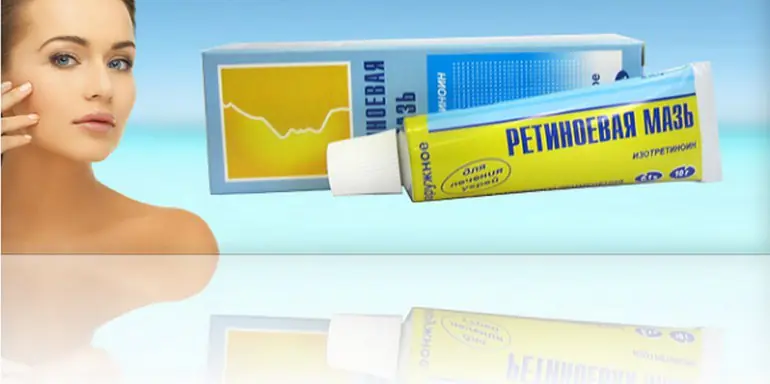
Retinoic ointment helps with acne if used correctly. The following positive changes in skin condition can be noted:
- exfoliation of dead areas of the epidermis occurs; skin metabolism is restored;
- the functioning of the sebaceous glands is normalized by reducing their secretion;
- helps against acne and blackheads, without leaving scars or scars;
- removes age spots and acne marks; inflammation around the glands is reduced;
- effective against stretch marks on the stomach and chest;
- provokes increased production of collagen in the dermis;
- stimulates its own regeneration processes;
- increases the immune properties of the skin, making them resistant to pathogenic bacteria and external irritants.
The degree of action of this medicine depends on its concentration. Having identified the troubling problem, the dermatologist prescribes a 0.05% drug (if small pimples, small wrinkles are bothering you, for prevention) or 0.1% (when there are more severe forms of rashes and obvious signs of aging).
Contraindications and side effects
Any medication is accompanied by an annotation describing the drug and its properties. The instructions for use require careful study, as they indicate the main contraindications and possible side effects.
The use of retinoic ointment is prohibited in the following cases:
- during the period of bearing a child and breastfeeding;
- if a future pregnancy is planned;
- with impaired liver and kidney function;
- excess vitamin A in the body;
- presence of chronic pancreatitis;
- if there are allergic reactions to synthetic components of the drug.
Most often, side effects occur in the first stages of treatment and disappear after some time. Also, undesirable manifestations are observed when the medicine is used incorrectly or are caused by the characteristics of the body. These include:
- dryness and peeling of the upper layers of the epidermis;
- slight burning sensation in the treated areas;
- irritation of the epidermis;
- sweating;
- an increase in the volume of rashes, as well as the size of individual pimples;
- redness and swelling at the application sites;
- increased sensitivity to ultraviolet radiation.
All these unpleasant symptoms arise due to the retinoic acid contained in it. Therefore, you should avoid overdose and strictly follow the treatment regimen indicated by the dermatologist. The topical drug is prescribed to representatives of both sexes and different age categories.
Application
Before you start fighting rashes, you need to figure out how to use this product to get the desired result and avoid side effects.
When retinoic ointment is prescribed for acne, the instructions imply the following application regimen:
- treat problem areas twice a day after thoroughly cleansing the epidermis;
- depending on the condition of the integument, the course ranges from four to six weeks.
In the first two weeks of therapy, an increase in the number of rashes is noted (thus, excess sebum is removed and metabolic processes in the dermis are stabilized). Treatment is stopped only if the rash, redness and swelling are severe. The maximum result can be assessed only after three months of use. To prevent acne from returning in the future, it is enough to treat the skin once every four days.
Since the drug has cumulative properties, to avoid an overdose, at the end of the course you should change the medicine to a product with a weaker concentration of the active ingredients.
There is another way to use retinoic ointment to avoid negative consequences for the face as much as possible.
- in the first days of use, the drug is applied only once a day, before bedtime;
- If in this case itching and redness appear, the problem areas are smeared every other day.
Over the course of two weeks, the epidermis adapts to the impact exerted on it. Then they switch to non-daily use, the number of procedures increases to twice a day. This method is suitable for people with sensitive skin and patients who do not have time for a rehabilitation period.
The basis of the ointment is Vaseline; it is considered a very greasy component that helps clog pores. This factor can harm problem skin, so the drug is applied pointwise, only to areas that require therapy.
Features of the drug
Before you start treatment with this remedy, you should familiarize yourself with some of its distinctive properties and recommendations from specialists:
- You should not treat with a retinoid before going outside in hot sunny weather, as it makes the epidermis more vulnerable to ultraviolet rays;
- When using, it is better to avoid sensitive areas (lips, skin around the eyes);
- if your skin type is dry, then this product should be combined with a nourishing cream to prevent flaking and a feeling of tightness;
- You cannot stop treatment abruptly, it is better to do it gradually;
- Initially, retinoic ointment for acne can have the opposite effect and increase the number of rashes. Do not panic, as this is a temporary phenomenon, and in a week the condition of the dermis will become much better;
- it is necessary to strictly follow the rules of application and the duration of the course, only in this case the ointment helps.
Reviews

Svetlana 24 years old:
I used different acne remedies, but they gave temporary results. I was interested in retinoic ointment for acne, reviews of which indicated a positive result. After completing the course, the effect really became noticeable. After a month, I practically got rid of not only acne, but also small wrinkles. To achieve clear skin, you need to have patience, since the first two weeks the inflammation becomes much greater, redness and peeling are disturbing.

Elizabeth 30 years old:
I have been using a lotion based on retinoic ointment for a very long time. I mix a spoonful of the product with the same volume of calendula tincture and two aspirin tablets. I apply it directly to acne and acne spots before bed. An effective method, I recommend it to everyone.

Alena 28 years old:
As summer approaches, the skin becomes more sensitive and acne appears. I took the risk of trying retinoic ointment on my own, without consulting a dermatologist. I was very afraid that it would irritate me even more (a common side effect), but this did not happen. Acne began to disappear after two weeks of treatment, and I noticed a reduction in the number of blackheads. The only drawback is that the skin becomes very dry, you have to constantly moisturize.
Retinoic ointment is a medicine, so it must be prescribed by a doctor. The drug not only removes bothersome symptoms, but also fights the causes of acne. Self-medication or violation of therapeutic standards indicated by a specialist can aggravate the situation and cause harm to the skin.



